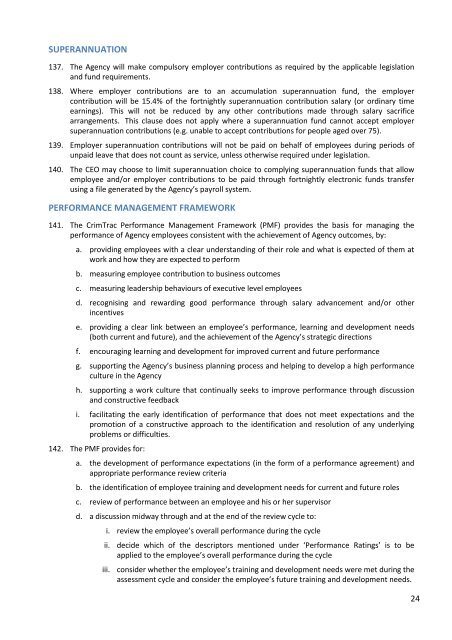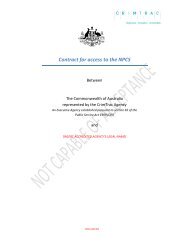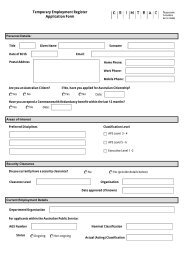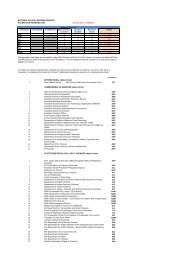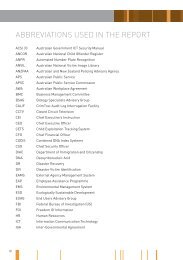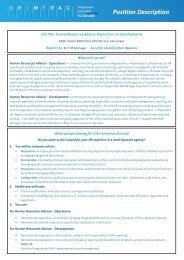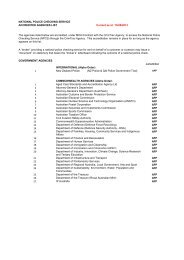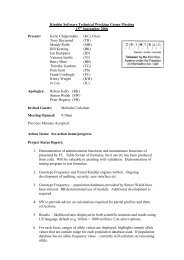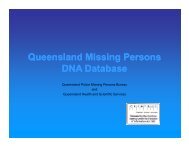CrimTrac Enterprise Agreement 2011-2014
CrimTrac Enterprise Agreement 2011-2014
CrimTrac Enterprise Agreement 2011-2014
Create successful ePaper yourself
Turn your PDF publications into a flip-book with our unique Google optimized e-Paper software.
SUPERANNUATION<br />
137. The Agency will make compulsory employer contributions as required by the applicable legislation<br />
and fund requirements.<br />
138. Where employer contributions are to an accumulation superannuation fund, the employer<br />
contribution will be 15.4% of the fortnightly superannuation contribution salary (or ordinary time<br />
earnings). This will not be reduced by any other contributions made through salary sacrifice<br />
arrangements. This clause does not apply where a superannuation fund cannot accept employer<br />
superannuation contributions (e.g. unable to accept contributions for people aged over 75).<br />
139. Employer superannuation contributions will not be paid on behalf of employees during periods of<br />
unpaid leave that does not count as service, unless otherwise required under legislation.<br />
140. The CEO may choose to limit superannuation choice to complying superannuation funds that allow<br />
employee and/or employer contributions to be paid through fortnightly electronic funds transfer<br />
using a file generated by the Agency’s payroll system.<br />
PERFORMANCE MANAGEMENT FRAMEWORK<br />
141. The <strong>CrimTrac</strong> Performance Management Framework (PMF) provides the basis for managing the<br />
performance of Agency employees consistent with the achievement of Agency outcomes, by:<br />
a. providing employees with a clear understanding of their role and what is expected of them at<br />
work and how they are expected to perform<br />
b. measuring employee contribution to business outcomes<br />
c. measuring leadership behaviours of executive level employees<br />
d. recognising and rewarding good performance through salary advancement and/or other<br />
incentives<br />
e. providing a clear link between an employee’s performance, learning and development needs<br />
(both current and future), and the achievement of the Agency’s strategic directions<br />
f. encouraging learning and development for improved current and future performance<br />
g. supporting the Agency’s business planning process and helping to develop a high performance<br />
culture in the Agency<br />
h. supporting a work culture that continually seeks to improve performance through discussion<br />
and constructive feedback<br />
i. facilitating the early identification of performance that does not meet expectations and the<br />
promotion of a constructive approach to the identification and resolution of any underlying<br />
problems or difficulties.<br />
142. The PMF provides for:<br />
a. the development of performance expectations (in the form of a performance agreement) and<br />
appropriate performance review criteria<br />
b. the identification of employee training and development needs for current and future roles<br />
c. review of performance between an employee and his or her supervisor<br />
d. a discussion midway through and at the end of the review cycle to:<br />
i. review the employee’s overall performance during the cycle<br />
ii. decide which of the descriptors mentioned under ‘Performance Ratings’ is to be<br />
applied to the employee’s overall performance during the cycle<br />
iii. consider whether the employee’s training and development needs were met during the<br />
assessment cycle and consider the employee’s future training and development needs.<br />
24


